Documentation
10 GDPR Cookie Banner Examples That Convert
What should cookie consent include? In this article, we will explore 10 outstanding GDPR cookie banner examples that not only fulfill their legal obligations, but also convert users!
Firstly, however, let’s examine the meaning of cookie consent.
What is cookie consent?
When is cookie consent needed?
In general, consent to cookies is needed if you have EU based users or are an EU based company, and run non-exempt cookies.
What should cookie consent include?
The process of collecting cookie consent includes clearly and explicitly informing the user of the cookies you run on your site, their purposes, the user’s right to grant or refuse consent, and how they can exercise that right.
The cookie consent must be informed, explicit and given via an unambiguous opt-in action.
Specifically, you must:
- display a clearly visible cookie banner/notice at the user’s first visit (you can read what the banner should contain here);
- provide a link in the banner to a more detailed cookie policy;
- block all non-exempt cookies and scripts from being run until after consent is received;
- collect consent via an explicit opt-in action.
What should my cookie consent banner say?
Your cookie consent banner should inform users of your use of cookies and similar technologies on your site, disclose their rights in relation to this, link to a cookie policy with more detailed information and give them the ability to either deny or grant consent.
- Disclosure: Start by acknowledging the use of cookies on your website and explain their purpose. Use a brief and straightforward statement to let visitors know that cookies are used to improve their browsing experience and provide personalized services.
- Consent Request: Clearly state that by continuing to browse the website, the visitor is giving their consent to the use of cookies. This emphasizes the importance of taking an action (e.g., continuing to browse) as a means of providing consent.
- Cookie Policy Link: Include a link to your Cookie Policy page where visitors can find more detailed information about the types of cookies used, their purpose, and how their data is processed. This link should direct users to a page that clearly explains your website’s cookie practices.
- Cookie Acceptance Button: Provide a prominent “Accept” button to make it easy for visitors to provide their consent. This button should be distinct and clearly labeled, allowing users to accept the use of cookies with a single click.
- Cookie Settings Button: Offer an additional option for visitors who wish to manage their cookie preferences. The “Cookie Settings” button should lead to a dedicated page where users can customize their cookie preferences, allowing them to enable or disable specific types of cookies.
Remember, it’s crucial to design your cookies notice in compliance with applicable privacy laws and regulations, such as the General Data Protection Regulation (GDPR) in the European Union or the California Consumer Privacy Act (CCPA) in the United States. Make sure to review and adapt the content and design of your cookie popup to meet the specific requirements of your jurisdiction.
Display Cookie Consent Banner Checklist
Use the following checklist to guide you through the process:
- Clear and Concise Language: Use simple and understandable language to explain the use of cookies and the purpose of the consent banner. Avoid technical jargon that may confuse visitors.
- Prominence and Visibility: Ensure that the cookie consent banner is prominently displayed on your website so that it is easily noticeable by visitors. Consider placing it at the top or bottom of the page to ensure visibility across different devices.
- Consent Mechanism: Provide a clear and unambiguous way for visitors to provide their consent to the use of cookies. This can be done through an “Accept” button, a checkbox, or any other user-friendly method that indicates an affirmative action.
- Cookie Policy Link: Include a prominent and easily accessible link to your Cookie Policy within the banner. This link should direct visitors to a page that provides detailed information about the types of cookies used, their purpose, and how their data is processed.
- Cookie Settings Option: Offer visitors the ability to manage their cookie preferences. Include a “Cookie Settings” button or link that directs them to a dedicated page where they can customize their preferences and enable or disable specific types of cookies.
- Responsiveness: Ensure that the cookies notice is responsive and displays correctly across different devices, including desktops, laptops, tablets, and mobile devices.
- Non-Obstructive Design: Design the banner in a way that is unobtrusive and does not interfere with the user experience. It should be easy for visitors to dismiss the banner if they choose not to provide consent.
- Automatic Cookie Placement: Make sure that cookies are not placed on the visitor’s device before obtaining their consent. Delay the placement of non-essential cookies until after the visitor has given their consent.
- Consent Granularity: If your website uses different types of cookies for various purposes, provide granular options for visitors to customize their preferences accordingly. This allows them to choose which specific types of cookies they consent to.
10 Cookie Banner Examples That Convert
Discover how over 1 Million websites, ranging from publishers to large-scale businesses and startups, have achieved GDPR compliance effortlessly with the help of iubenda’s Privacy Controls and Cookie Solution.
Below, we’ve selected a few prime cookie banner examples of European websites that have successfully implemented a cookie notice with iubenda.
1. Linkbuilder
Linkbuilder shows an example of a cookie popup that displays granular consent. This approach puts user experience and transparency at the forefront. By allowing users to selectively choose which specific types of cookies they wish to accept, it respects their privacy preferences while increasing your chances of collecting consent. This approach not only enhances user trust but also aligns with evolving data protection regulations and best practices.

2. Crazy Games
Crazy Game is the first company on our cookie banner examples list. Popping up in the middle of the screen, it is a great example of a banner that’s customized to fit brand identity – see how they have added their logo. Find out how to customize a cookie banner with iubenda here →

3. The Spectator
The example of a cookie banner that pops up on the right-hand side of the screen on The Spectator site is a good example because it strikes a balance between visibility and non-intrusiveness. Placing the banner on the side allows users to easily notice and interact with it without obstructing the main content.
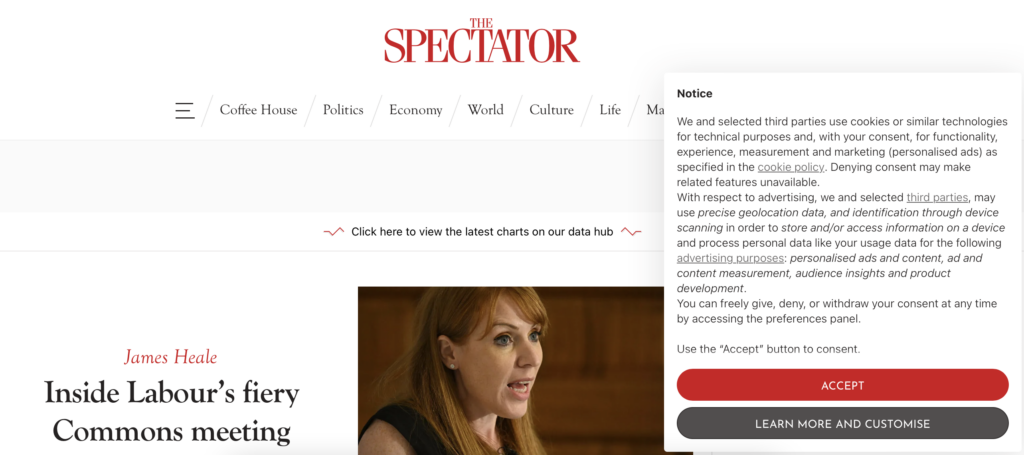
4. la Repubblica
The publication la Republica is a good example of how transparency can boost conversion. The publication explains their purposes for running personalized ads and gives users the option to subscribe to their paid publication for an ad-free experience. You can read more about paywalls for publishers here →
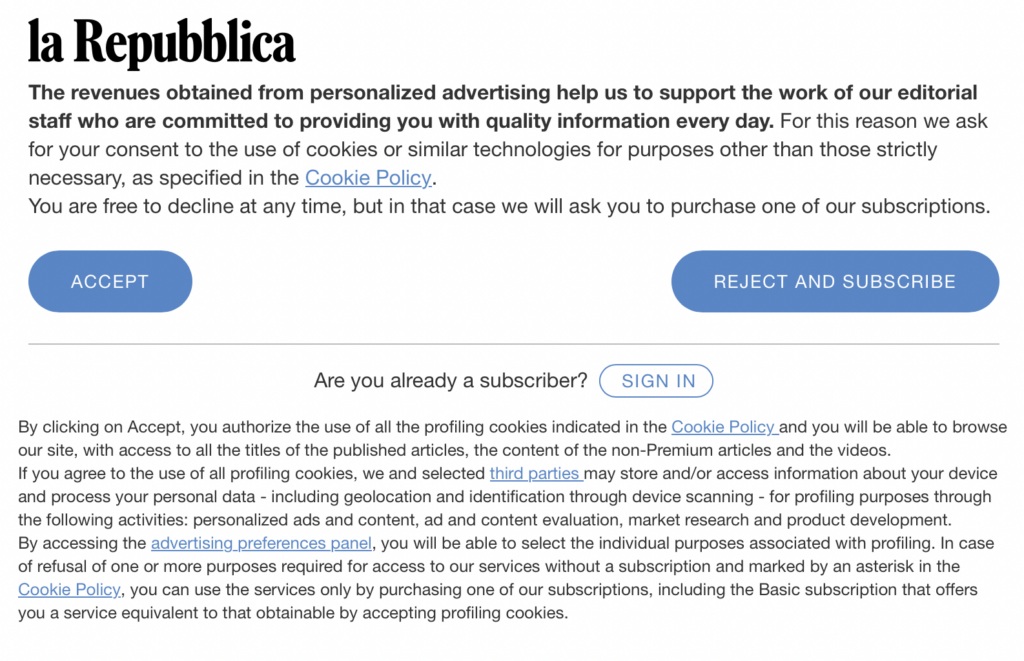
5. Max Mara
The simple but elegant cookie banner that pops up on the footer of the Max Mara site is a good example of persistent visibility without interrupting the user’s browsing experience. The inclusion of a “Continue without accepting” option respects user preferences and provides an alternative for those who may choose not to consent to cookies, promoting user choice and privacy.
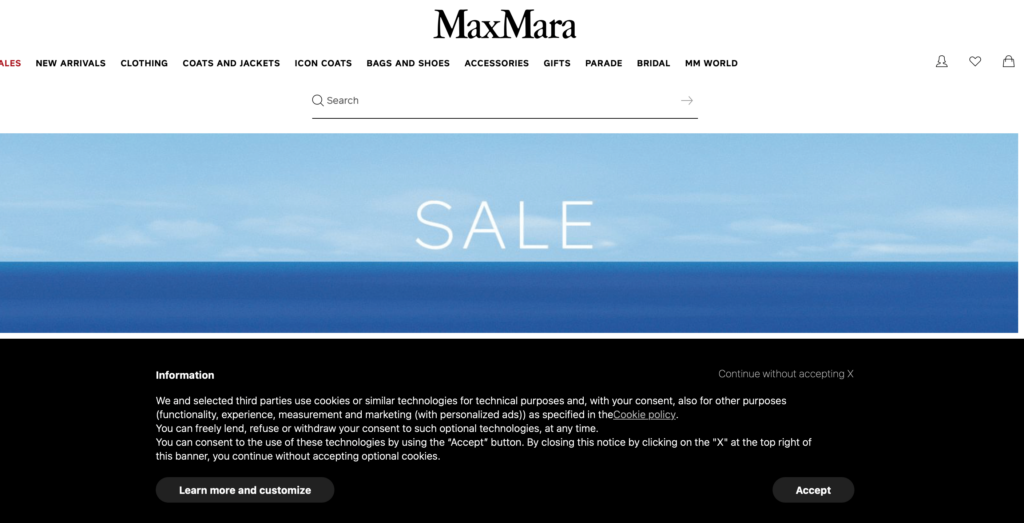
6. Adidas
The Adidas cookie banner has a floating banner on their website that adheres to GDPR. The banner features ‘accept’ and ‘reject’ buttons placed at an equal levels, with the same color and level of visual prominance. Ensuring that it’s not just in line with laws like the GDPR and ePrivacy, but also with the French DPA’s (the CNIL) guidelines.
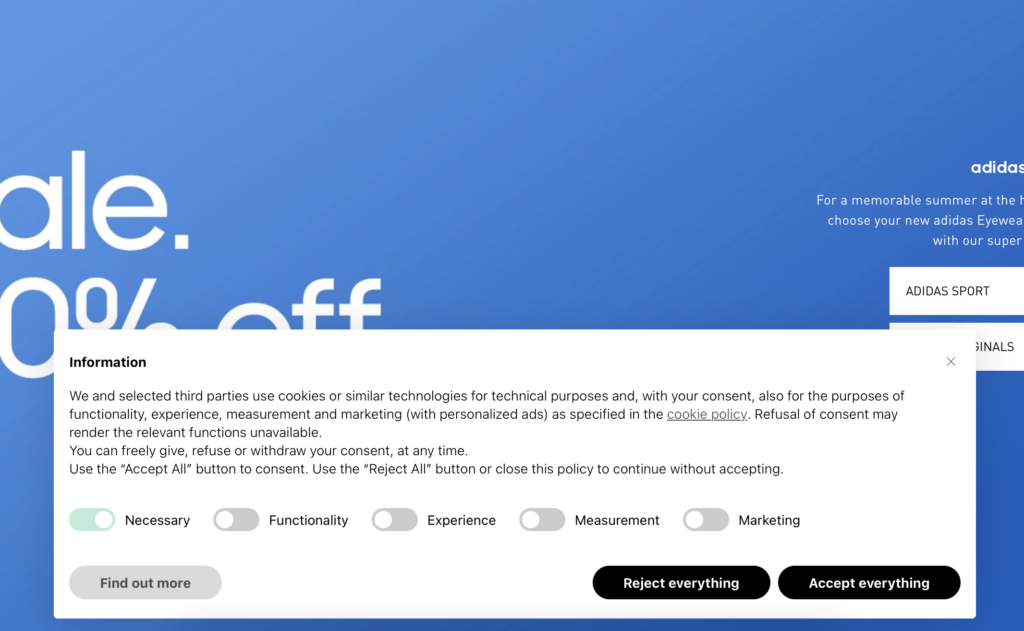
7. Barbour
The Barbour’s site hosts a great example of a cookie popup that’s simple, clear and matches the minimalist style of the site and brand. Additionally, the clear link to the cookie policy ensures transparency and enables users to make informed choices about their data privacy.

8. Barton Perreira
Similar to the cookie banner examples above, the eyewear designer Barton Perreira’s banner is a prominent, yet elegant one. They list purposes, and link to their cookie policy. With iubenda, they were able to customize the banner by adding their logo on the top left corner.
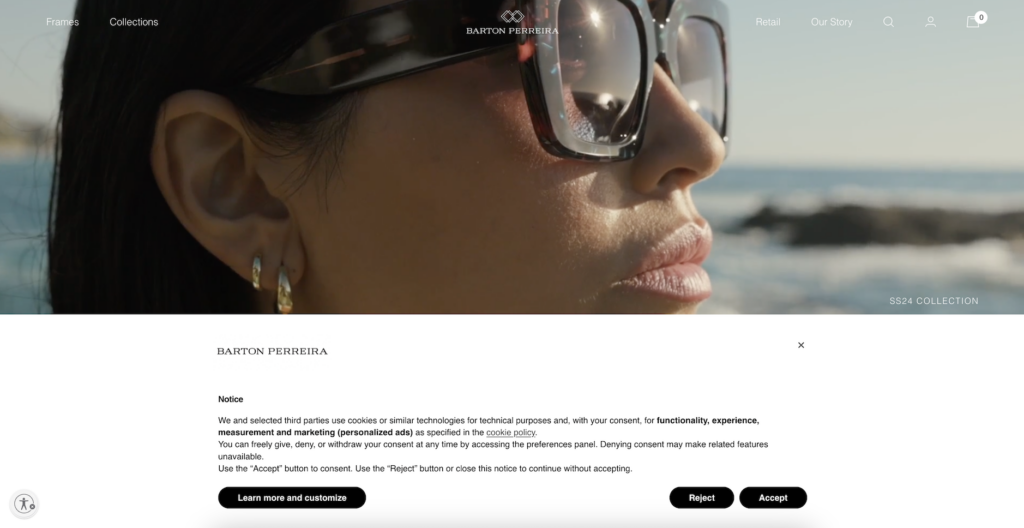
9. ITA Airways
The main Italian airline company ITA Airways uses iubenda to display a cookie banner in the center of their website at the user’s first visit. To make it more visible, the background is darker.

10. Armani Hotel & Resorts
The last one of our cookie banner examples is a short cookie message on the Armani Hotel & Resorts’s site with both an ‘Accept All’ and ‘Reject All’ button. Its design reflects the same search banner look at the bottom.
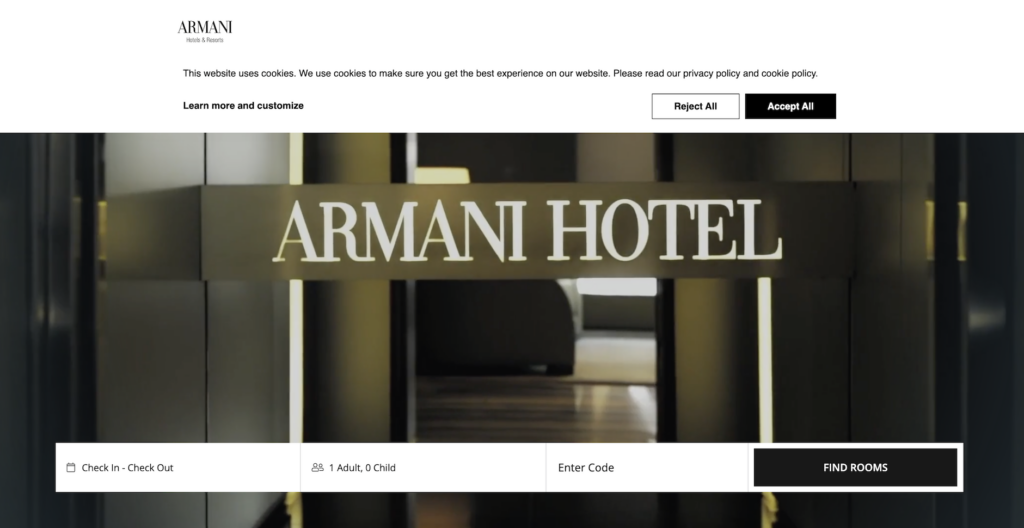
Frequently Asked Questions
How does cookie consent function?
Cookie consent is implemented through the display of a cookie banner or popup when a user visits a website. This allows users to choose whether to accept (give consent), reject, or customize their cookie preferences. By granting consent, users may enable or disable specific cookie categories, except for strictly necessary cookies. Consent can be withdrawn at any time, and the cookie consent banner typically includes a “cookie widget” or callback button for users to revisit their cookie settings.
What is the duration of cookie consent?
Cookie consent should be renewed at least once a year in compliance with the ePrivacy Directive. However, local data protection authorities (DPAs) may provide guidelines for periodic renewal. For example, the Irish DPC and the French CNIL recommend re-obtaining consent no later than every six months. The GDPR does not specify a specific timeframe, so it is advisable to establish a renewal period based on your respective DPA’s guidance.
👀 See How to easily Display the Cookie Lifetime in Your Cookie Policy with iubenda →
Is cookie consent necessary for Google Analytics?
If your website employs third-party analytics services like Google Analytics that collect and process visitors’ personal data, obtaining consent is required.
According to Google’s official guidance, if you have activated Google Analytics Advertising Features such as remarketing and display network impression reporting, you must acquire consent for cookies and disclose this information in your privacy policy. Additionally, it is recommended to consider obtaining consent for the collection of user IDs, pseudonymous identifiers, and geographic data (e.g., postal code, location coordinates).
What is a cookie consent manager?
A cookie consent manager is a specialized tool or software designed to acquire and handle cookie consent on a website. Given the potential privacy concerns associated with cookies, strict regulations are in place.
iubenda’s Privacy Controls and Cookie Solution enables website owners to obtain explicit permission from visitors for cookie usage, block third-party cookies until consent is granted, provide options for users to opt in or out, and store their cookie consent preferences. By using iubenda, website owners can ensure compliance with privacy laws and empower users to exercise control over their cookie preferences.
What is a cookie popup?
A “cookie popup” is another way to call the cookie banner or cookies notice, and it refers to a notification or alert that appears on a website when a user first visits it. This notification is typically in the form of a banner.
It informs the user about the site’s use of cookies and requests the user’s consent to store or retrieve information on their device.
Why are websites showing cookie warnings?
Cookie warnings on websites are actually required by law in certain regions. The requirement largely stems from privacy and data protection regulations. Notably, the General Data Protection Regulation (GDPR) in the European Union and the ePrivacy Directive (often referred to as the “Cookie Law”) have established guidelines requiring websites to inform users and obtain their consent from users before any non-essential cookies are used.
This is why you often see a popup asking for your consent to cookies when you visit a website for the first time, especially if the site operates in or serves users in the EU. Cookies are small pieces of data that can identify you, hence them being regulated. They are used to recall your session preferences (e.g. language, login info), to target you with personalized ads, or to track your behavior (e.g. shopping cart, how long you spent on a page).